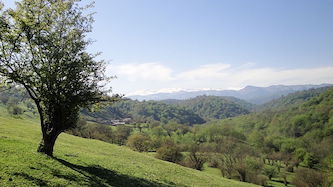The recent felling of a 300-year-old kola tree in Ghana has sparked outrage among the local community. The tree, which was believed to possess healing powers, had significant historical and cultural importance as it dated back to the Ashanti Kingdom in the early 1700s. Many Ghanaians revered the tree, as it was associated with the renowned priest Komfo Anokye, who was believed to have spat a kola nut on the ground at the tree’s location.
The kola tree was located in the town of Feyiase and had been spared during the construction of a major road due to its popularity as a tourist attraction. The tree’s sudden felling has left the community puzzled and dismayed. The site of the tree holds historical significance, as it was the location of the Battle of Feyiase, where the Ashanti people fought for their independence against the kingdom of Denkyira.
Komfo Anokye, a powerful fetish priest, was closely associated with the tree and the surrounding area. According to oral tradition, he buried a sword in the ground at the premises of a hospital in Kumasi that bears his name, and the presence of the kola tree served as a constant reminder of his legendary exploits. The tree’s destruction has prompted a manhunt for those responsible for its felling, as Ghanaians express their dismay and outrage over the loss of this significant cultural and historical symbol.
The director of research at Manhyia Palace, the seat of the Ashanti royal family, emphasized the importance of the tree’s location in the history of the Ashanti Kingdom. The tree’s black and white seeds were believed to possess healing properties, and its destruction has left many Ghanaians deeply saddened. The incident has also garnered attention online, with images of the felled tree circulating and sparking widespread concern and condemnation.
Original news source: Komfo Anokye kola tree: Ghana outrage after 300-year-old tree felled (BBC)
Listen
Slow
Normal
Fast
Group or Classroom Activities
Warm-up Activities:
– News Summary
Instructions: Students will work in pairs to summarize the article in their own words, focusing on the main points: the historical and cultural significance of the kola tree, the connection to Komfo Anokye, the community’s reaction to the tree’s felling, and the significance of the tree’s location. Each pair will then present their summary to the class.
– Mind Map
Instructions: Provide the students with a large piece of paper and markers. Ask them to create a mind map that visually represents the relationships and key elements of the article, including the kola tree, Komfo Anokye, the Ashanti Kingdom, the Battle of Feyiase, and the recent felling incident. Once completed, students can present their mind maps and discuss the connections they have made.
– Opinion Spectrum
Instructions: Create a line in the classroom that represents a spectrum of opinions from “strongly agree” to “strongly disagree.” Read out statements related to the article, such as “Historical landmarks should be preserved at all costs,” and “The felling of the kola tree was a necessary act for progress.” Have students physically place themselves along the spectrum according to their opinion and discuss their reasoning with classmates nearby.
– Vocabulary Pictionary
Instructions: Write down key terms from the article (e.g., “felling,” “revered,” “outrage,” “healing powers,” “cultural significance”) on slips of paper. Divide the class into two teams and play Pictionary, where one student from a team draws the term without speaking or writing words, while their teammates guess the term within a time limit. Rotate the role of the drawer with each term.
– Future Predictions
Instructions: Ask the students to write a short paragraph predicting the future implications of the kola tree’s felling on the local community and the Ashanti Kingdom’s cultural heritage. Encourage them to use modal verbs of speculation and prediction, such as “might,” “could,” “may,” and “will.” After writing, students can share their predictions in small groups and discuss the potential outcomes.
Comprehension Questions:
1. How old was the kola tree that was felled in Ghana?
2. What kind of powers was the kola tree believed to possess?
3. What is the historical significance of the kola tree’s location in relation to the Ashanti Kingdom?
4. Who was Komfo Anokye and how was he associated with the kola tree?
5. Why was the kola tree spared during the construction of a major road?
6. What historical event took place at the site of the kola tree in Feyiase?
7. What action has the local community taken in response to the tree’s felling?
8. What specific aspect of the kola tree’s seeds was believed to be beneficial, and how has its destruction affected the Ghanaians?
Go to answers ⇩
Listen and Fill in the Gaps:
The recent (1)______ of a 300-year-old kola tree in Ghana has sparked outrage among the local community. The tree, which was believed to possess healing powers, had significant historical and cultural importance as it dated back to the Ashanti Kingdom in the early (2)______. Many Ghanaians (3)______ the tree, as it was associated with the renowned priest Komfo Anokye, who was believed to have spat a kola nut on the (4)______ at the tree’s location.
The kola tree was located in the town of Feyiase and had been spared during the (5)______ of a major road due to its popularity as a tourist attraction. The tree’s sudden felling has left the community puzzled and dismayed. The site of the tree holds historical significance, as it was the location of the Battle of Feyiase, where the Ashanti people fought for their independence against the kingdom of Denkyira.
(6)______ Anokye, a (7)______ fetish (8)______, was closely associated with the tree and the (9)______ area. According to oral (10)______, he buried a sword in the ground at the premises of a hospital in Kumasi that bears his name, and the presence of the kola tree served as a (11)______ reminder of his legendary exploits. The tree’s destruction has (12)______ a manhunt for those responsible for its felling, as Ghanaians express their dismay and outrage over the loss of this significant cultural and historical symbol.
The (13)______ of research at Manhyia Palace, the seat of the Ashanti royal family, emphasized the importance of the tree’s location in the history of the Ashanti Kingdom. The tree’s black and white seeds were believed to possess healing properties, and its destruction has left many Ghanaians deeply saddened. The (14)______ has also garnered attention online, with (15)______ of the felled tree circulating and sparking (16)______ concern and condemnation.
Go to answers ⇩
Discussion Questions:
Students can ask a partner these questions, or discuss them as a group.
1. What is the significance of historical landmarks or natural monuments in your own culture or country?
2. How would you feel if a natural landmark or historical monument important to your community was suddenly destroyed?
3. Do you think that the protection of culturally significant trees or landmarks should be prioritized over urban development? Why or why not?
4. Have you ever visited a place that was believed to have healing powers or spiritual significance? What was that experience like?
5. What is your opinion on the role of oral tradition in preserving history, similar to the stories surrounding Komfo Anokye and the kola tree?
6. Do you believe in the spiritual or healing properties of certain plants or natural objects? Why or why not?
7. How do you think communities should respond to the destruction of their cultural or historical symbols?
8. Do you think that the felling of the kola tree in Ghana will have long-term effects on the local community’s culture? Why or why not?
9. Have you ever been involved in or witnessed activism to protect a cultural or historical site? What was the outcome?
10. Do you like the idea of combining tourism with the preservation of natural and historical sites? Why or why not?
11. How do you think modern societies can balance development with the preservation of historical and cultural heritage?
12. Do you think that the international community should get involved when a site of historical or cultural significance is threatened? Why or why not?
13. Have you ever experienced outrage or dismay in your community similar to what the Ghanaians are feeling about the kola tree? What was the cause?
14. What is your perspective on the importance of maintaining physical reminders, like the kola tree, of historical events or figures?
15. Do you think that the story of the kola tree and its alleged healing powers will change now that the tree has been cut down? How might it evolve?
Individual Activities
Vocabulary Meanings:
Match each word to its meaning.
Words:
1. felling
2. Ghana
3. historical
4. cultural
5. Ashanti
6. destruction
7. significance
8. outrage
Meanings:
(a) The importance or meaning of something
(b) Relating to the past
(c) A country in West Africa
(d) The act of cutting down a tree
(e) Relating to the customs and beliefs of a group
(f) The act of causing great damage
(g) An ethnic group in Ghana
(h) Strong feeling of anger and shock
Go to answers ⇩
Multiple Choice Questions:
1. What was the significance of the kola tree in Ghana?
(a) It was a popular spot for picnics
(b) It was a famous landmark for birdwatching
(c) It was a location for political rallies
(d) It had healing powers and historical importance
2. Why was the kola tree spared during the construction of a major road?
(a) It was considered a sacred site for the community
(b) It was home to a rare species of bird
(c) It was a popular tourist attraction
(d) It was a location for important historical events
3. Who was Komfo Anokye?
(a) A famous musician from Ghana
(b) A renowned priest associated with the kola tree
(c) A political leader in the Ashanti Kingdom
(d) A famous explorer from the 1700s
4. What did Komfo Anokye do at the location of the kola tree?
(a) He planted the tree himself
(b) He spat a kola nut on the ground
(c) He built a shrine in its honor
(d) He performed a healing ritual
5. What prompted a manhunt in Ghana?
(a) The felling of the kola tree
(b) A robbery at a local bank
(c) A political protest
(d) A wildlife poaching incident
6. What did the black and white seeds of the kola tree possess?
(a) Healing properties
(b) Magical powers
(c) Poisonous properties
(d) Nutritional benefits
7. What has the destruction of the kola tree led to?
(a) A surge in tourism to the area
(b) A decrease in local interest in historical sites
(c) Widespread concern and condemnation
(d) A rise in property values in the town of Feyiase
8. Where is Manhyia Palace located?
(a) In the town of Feyiase
(b) In the capital city of Ghana
(c) At the site of the Battle of Feyiase
(d) The seat of the Ashanti royal family
Go to answers ⇩
True or False Questions:
1. Komfo Anokye was closely associated with the tree and the surrounding area, and according to oral tradition, he buried a sword in the ground at the premises of a hospital in Kumasi that bears his name.
2. The felling of a 300-year-old kola tree in Ghana has caused indifference in the local community.
3. The destruction of the tree has prompted no reaction from Ghanaians, as they show no concern or outrage over the loss of this significant cultural and historical symbol.
4. The incident has garnered attention online, with images of the felled tree circulating and sparking widespread concern and condemnation.
5. The site of the tree holds historical significance as it was the location of the Battle of Feyiase, where the Ashanti people fought for their independence against the kingdom of Denkyira.
6. The tree had been cut down during the construction of a major road despite its popularity as a tourist attraction.
7. The tree was associated with the renowned priest Komfo Anokye, who was believed to have planted a kola nut on the ground at the tree’s location.
8. The kola tree was believed to have healing powers and had historical and cultural significance dating back to the Ashanti Kingdom in the early 1700s.
Go to answers ⇩
Write a Summary:
Write a summary of this news article in two sentences.
Check your writing now with the best free AI for English writing!
Writing Questions:
Answer the following questions. Write as much as you can for each answer.
Check your answers with our free English writing assistant!
1. What historical event is associated with the location of the felled kola tree in Feyiase?
2. Who was Komfo Anokye, and how was he connected to the kola tree?
3. What was the cultural significance of the kola tree’s black and white seeds to the local community?
4. How has the community reacted to the felling of the kola tree, and what actions are being taken in response?
5. What role does the Manhyia Palace play in emphasizing the importance of the kola tree, and how has the incident been reflected on social media?
Answers
Comprehension Question Answers:
1. How old was the kola tree that was felled in Ghana?
The kola tree was 300 years old.
2. What kind of powers was the kola tree believed to possess?
The kola tree was believed to possess healing powers.
3. What is the historical significance of the kola tree’s location in relation to the Ashanti Kingdom?
The kola tree’s location was significant as it dated back to the Ashanti Kingdom in the early 1700s and was the site of the Battle of Feyiase, where the Ashanti people fought for their independence against the kingdom of Denkyira.
4. Who was Komfo Anokye and how was he associated with the kola tree?
Komfo Anokye was a renowned priest associated with the Ashanti Kingdom. He was believed to have spat a kola nut on the ground at the tree’s location and buried a sword in the ground at the premises of a hospital in Kumasi that bears his name.
5. Why was the kola tree spared during the construction of a major road?
The kola tree was spared during the construction of a major road due to its popularity as a tourist attraction.
6. What historical event took place at the site of the kola tree in Feyiase?
The Battle of Feyiase took place at the site of the kola tree in Feyiase.
7. What action has the local community taken in response to the tree’s felling?
The local community has initiated a manhunt for those responsible for the felling of the tree.
8. What specific aspect of the kola tree’s seeds was believed to be beneficial, and how has its destruction affected the Ghanaians?
The black and white seeds of the kola tree were believed to possess healing properties. Its destruction has left many Ghanaians deeply saddened and has sparked outrage among the community.
Go back to questions ⇧
Listen and Fill in the Gaps Answers:
(1) felling
(2) 1700s
(3) revered
(4) ground
(5) construction
(6) Komfo
(7) powerful
(8) priest
(9) surrounding
(10) tradition
(11) constant
(12) prompted
(13) director
(14) incident
(15) images
(16) widespread
Go back to questions ⇧
Vocabulary Meanings Answers:
1. felling
Answer: (d) The act of cutting down a tree
2. Ghana
Answer: (c) A country in West Africa
3. historical
Answer: (b) Relating to the past
4. cultural
Answer: (e) Relating to the customs and beliefs of a group
5. Ashanti
Answer: (g) An ethnic group in Ghana
6. destruction
Answer: (f) The act of causing great damage
7. significance
Answer: (a) The importance or meaning of something
8. outrage
Answer: (h) Strong feeling of anger and shock
Go back to questions ⇧
Multiple Choice Answers:
1. What was the significance of the kola tree in Ghana?
Answer: (d) It had healing powers and historical importance
2. Why was the kola tree spared during the construction of a major road?
Answer: (c) It was a popular tourist attraction
3. Who was Komfo Anokye?
Answer: (b) A renowned priest associated with the kola tree
4. What did Komfo Anokye do at the location of the kola tree?
Answer: (b) He spat a kola nut on the ground
5. What prompted a manhunt in Ghana?
Answer: (a) The felling of the kola tree
6. What did the black and white seeds of the kola tree possess?
Answer: (a) Healing properties
7. What has the destruction of the kola tree led to?
Answer: (c) Widespread concern and condemnation
8. Where is Manhyia Palace located?
Answer: (d) The seat of the Ashanti royal family
Go back to questions ⇧
True or False Answers:
1. Komfo Anokye was closely associated with the tree and the surrounding area, and according to oral tradition, he buried a sword in the ground at the premises of a hospital in Kumasi that bears his name. (Answer: True)
2. The felling of a 300-year-old kola tree in Ghana has caused indifference in the local community. (Answer: False)
3. The destruction of the tree has prompted no reaction from Ghanaians, as they show no concern or outrage over the loss of this significant cultural and historical symbol. (Answer: False)
4. The incident has garnered attention online, with images of the felled tree circulating and sparking widespread concern and condemnation. (Answer: True)
5. The site of the tree holds historical significance as it was the location of the Battle of Feyiase, where the Ashanti people fought for their independence against the kingdom of Denkyira. (Answer: True)
6. The tree had been cut down during the construction of a major road despite its popularity as a tourist attraction. (Answer: False)
7. The tree was associated with the renowned priest Komfo Anokye, who was believed to have planted a kola nut on the ground at the tree’s location. (Answer: False)
8. The kola tree was believed to have healing powers and had historical and cultural significance dating back to the Ashanti Kingdom in the early 1700s. (Answer: True)
Go back to questions ⇧













